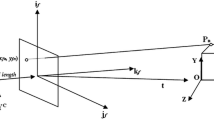Abstract
One of the main issues in the area of motion estimation given the correspondences of some features in a sequence of images is sensitivity to error in the input. The main way to attack the problem, as with several other problems in science and engineering, is redundancy in the data. Up to now all the algorithms developed either used two frames or depended on assumptions about the motion or the shape of the scene. We present in this paper an algorithm based on multiple frames that employs only the rigidity assumption, is simple and mathematically elegant and, experimentally proves to be a major improvement over the two-frame algorithms. The algorithm does minimization of the squared error which we prove equivalent to an eigenvalue minimization problem. One of the side effects of this mean-square method is that the algorithm can have a very descriptive physical interpretation in terms of the “loaded spring model.”
Similar content being viewed by others
References
Broida, T.J., and Chellappa, R. 1986. Estimation of object motion parameters from noisy images, IEEE Trans. Patt. Anal. Mach. Intell. 8(1):90–99.
Broida, T.J., and Chellappa, R. 1989. Performance bounds for estimating three-dimensional motion parameters from a sequence of noisy images. J. Opt. Soc. Amer. A 6(6):879–889.
Faugeras, O., Lustman, F., and Toscani, G. 1987. Motion and structure from point and line matches. Proc. Intern. Conf. Comput. Vision.
Horn, B.K.R. 1987. Motion fields are hardly ever ambiguous. Intern. J. Comput. Vision 1:259–274.
Kato, Tosio. 1976. Perturbation Theory for Linear Operators. Springer-Verlag.
Matthies, L., Szelisky, R., and Kanade, T. 1988. Incremental estimation of dense depth maps from image sequences. Proc. CVPR-88.
Shariat, H. 1986. The motion problem: How to use more than two frames. Rept. IRIS-202, University of Southern California, Institute for Robotics and Intelligent Systems, Los Angeles, CA, October.
Shariat, H. 1986. Ph.D. thesis, University of Southern California, Los Angeles.
Shulman, D., and Alolmonos, J.Y. 1988. (Non)rigid motion interpretation: A regularized approach. Proc. Roy. Soc. London B223:217–234.
Spetsakis, M.E., and Aloimonos, J. 1987. Closed form solution to the structure from motion problem from line correspondencees. Proc. Amer. Assoc. Artif. Intell.
Spetsakis, M.E., and Aloimonos, J. 1988. Optimal estimation of structure from motion from point correspondences in two frames. Proc. Intern. Conf. Comput. Vision.
Stoer, J., and Bulirsch, R. 1980. Introduction to Numerical Analysis, Springer-Verlag.
Tsai, r.-Y., and Huang, T.-S. 1984. Uniqueness and estimation of three dimensional motion parameters fo rigid objects with curved surfaces. IEEE Trans. Patt. Anal. Mach. Intell. 6:13–27.
Weng, J., Huang, T.-S., and Ahuja, N. 1987. 3-D motion estimation, understanding and prediction from noisy image sequences. IEEE Trans. Patt. Anal. Mach. Intell. 9(3):370–389.
Weng, J., Huang, T.-S., and Ahuja, N. 1987. A two step approach to optimal motion and structure estimation. Proc. IEEE Comput. Soc. Worksh. Comput. Vision.
Young, G.S., and Chellappa, R. 1988. 3-D motion estimation using a sequence of noisy stereo images. Proc. CVPR-88.
Young, G.S., and Chellappa, R. 1990. 3-D motion estimation using a sequence of noisy stereo images. IEEE Trans. Patt. Anal. Mach. Intell. 12(8):735–759.
Author information
Authors and Affiliations
Rights and permissions
About this article
Cite this article
Spetsakis, M., Aloimonos, J.Y. A multi-frame approach to visual motion perception. Int J Comput Vision 6, 245–255 (1991). https://doi.org/10.1007/BF00115698
Received:
Revised:
Issue Date:
DOI: https://doi.org/10.1007/BF00115698




